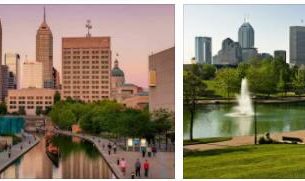TERRITORY: HUMAN GEOGRAPHY. THE POPULATION
At the time of its discovery by the Europeans, the Canadian territory was home to several hundred thousand Indians and in the “Great North” several tens of thousands of Inuit (Eskimos). Now these communities constitute a minimal percentage (0.2% Inuit and 2.2% Amerindian) of the total population, represented by Europeans, mostly of French origin (13.6%) and Anglo-Saxon (45.6%). The European occupation of Canada came with a certain delay compared to that of the United States. The island of Terranova was discovered by Giovanni Caboto in 1497 and in 1524 Giovanni da Verrazzano explored the coast as far as the island of Cape Breton, calling those lands “New France”. Jacques Cartier he discovered and partly went up the San Lorenzo, but only at the beginning of the century. XVII Samuel de Champlain founded the first settlements, including Port Royal in Nova Scotia (long called Acadia) and Québec. The population was fed by French colonists; in 1722 there were 25,000 French in New France, which became 70,000 in 1760, although they encountered strong hostility from the English, who had been operating in those territories for some time with the Hudson’s Bay Company. With the annexation of Canada to the British crown there was a strong immigration of English coming mainly from the Atlantic colonies at the time of the war of independence of the future United States: 40,000 arrived between 1777 and 1784. They settled in N and a And of Lake Ontario (current provinces of Ontario and New Brunswick): from this originated the distinction between “Upper Canada”, populated by Anglo-Saxons, and “Lower Canada” (province of Québec) inhabited by French, corresponding to the region traveled by the San Lorenzo. The population of the “lower Canada” grew as a natural demographic impulse, that of the “upper Canada” above all due to the continuous immigration from the United States, from which ranks of settlers were left attracted by the arable land of the Great Lakes region. The contrasts between the French and the Anglo-Saxons accompanied the development of the country which, having acquired independence, gave itself a federal government, as a reflection of the binational structure of the new state. According to ethnicityology, the population of the Central Plains and western Canada, which until then had remained almost the exclusive domain of the Hudson’s Bay Company for the fur trade, was then driven by gold prospectors and then settlers, convinced of the riches of those lands: the construction of the Canadian Pacific Railway (1885), which linked the East to the West, was decisive in this case. Immigration became very substantial from the end of the nineteenth century and did not come only, as in the beginning, from the United States, but directly from Europe, especially from Great Britain, Ireland, the Slav countries, Italy; overall, between 1900 and 1915 immigrants exceeded three million. With the First World War the flow contracted; restrictive laws were then instituted which kept immigration on annual quotas between 70,000 and 160,000 units, which decreased further after 1930. After the Second World War, the flow resumed, although well selected in relation to the needs of the country: in the thirty-year period 1950 -80 more than 3.5 million people arrived in Canada. For the purposes of demographic increase immigration was undoubtedly decisive (without neglecting the large number of people who then passed to the USA or repatriated); However, the natural increase, always high, also had a considerable weight. The population, which in 1850 was 2.4 million, at the beginning of the century increased to 5.3 million, in 1931 to 10 million, up to almost 40 million today. A country of strong and varied immigration, Canada has an extremely composite ethnic structure. Of those born in Canada, just over half are of British descent; in addition to the French, about twenty nationalities are represented, among which the Germans, the Italians, the Ukrainians, the Dutch and the Poles predominate. Over one million of those born abroad come from Great Britain and around 280,000 from the United States. The ethnic and cultural diversity of the Canadian population has increased with the arrival of immigrants from Asia (mainly Chinese, then Indians, Filipinos and Vietnamese) and the Antilles, while those from Europe are decreasing. In the mid-1980s, immigration was regulated by specific quotas and did not reach 100,000 units per year. However, the migratory balance remains positive: in 2018 about 70,000 Canadians emigrated while the country welcomed over 321,065 individuals. Canada also hosts a high number of refugees and asylum seekers, about 10,000 in 2006, the third in the world after the United States and Australia; the 2002 agreements with the United States (in 2018 about 70,000 Canadians emigrated while the country welcomed over 321,065 individuals. Canada also hosts a high number of refugees and asylum seekers, around 10,000 in 2006, the third in the world after the United States and Australia; the 2002 agreements with the United States (in 2018 about 70,000 Canadians emigrated while the country welcomed over 321,065 individuals. Canada also hosts a high number of refugees and asylum seekers, around 10,000 in 2006, the third in the world after the United States and Australia; the 2002 agreements with the United States (Safe Third Country Agreement) require new arrivals to apply for refugee status to the first country they arrive in, with the aim of monitoring the borders more carefully and avoiding clandestine movements between the two states. Even the natural growth rates, which in the first half of the century. XX reached high levels (about 2.5%), contributing significantly to the overall increase in the population, starting from the 1960s they reached lower values (1.8%), to drop further in the following decades: in the five-year period 2015-2020, annual growth settles at around 0.9%. The average birth rate is 9.7 ‰, but there are considerable differences between area and area: in fact, the more recently colonized rural areas have higher birth rates.




